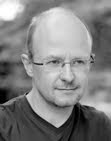Manufactured Landscapes
 Talking about Burtynsky: a few weeks ago I saw the “Manufactured Landscapes” documentary on his great photographic journey documenting the impact of globalisation on our planet. One wonders how a good film can be made about someone who just happens to produce still images at all corners of the earth.
Talking about Burtynsky: a few weeks ago I saw the “Manufactured Landscapes” documentary on his great photographic journey documenting the impact of globalisation on our planet. One wonders how a good film can be made about someone who just happens to produce still images at all corners of the earth. Well, it’s certainly not a bad movie. The opening shot is even memorable: a camera dollies through the endless corridor of a Chinese factory hall impartially registering row upon row upon row of workers assembling something that turns out to be nothing less than an iron. The rest of the movie meanders associatively through the chapters of Burtynsky’s magnum opus: quarries, ship building and ship breaking, oil fields, refineries, and of course a good deal on China: factories, recycling dumps, the Three Gorges Dam, the explosive urbanisation of Shangai (and other megalopoles). We see the photographer at work, mapping scenes, wielding his Linhof Technika (which looks really diminutive against the vast contraptions he chooses to document), directing groups of people, studying polaroids, waiting for the light. It’s good to know some his pictures are set in scene. But most of the film is devoted to re-filming many of the sites he visited with a narrative overlaid on top.
Conceptually, the photographer has not a lot to tell. Of course, he shows only that side of globalisation that is tied up with the movements of commodities (ore, oil, bulk materials, finished products, rubbish). The other side – linked to the staggering financial flows permeating the planetary noosphere – is invisible to the photographic eye. What Burtynsky’s photos show above all is that man is an “additive” animal. If we need more ore, we dig deeper pits; if we need more transport capacity, we build bigger ships; if we need more energy, we build bigger dams; if we need more stuff, we build bigger factories; if we want to accomodate more people, we build bigger cities. Nowhere is a feeling for complexity in sight, for leverage points that allow us to accomplish more with less input, for the power of contemplating knotted - and not just the predictability of flat - topological space.
A question I ask myself: why is Burtynsky’s work beautiful? What’s the purpose of the beauty? Burtynsky says he doesn’t want to take position, but obviously he does. He couldn’t do otherwise. Does beauty invariably amount to an endorsement and ugliness to a condemnation? I don’t know. The photographer does not address the question.


0 Comments:
Post a Comment
<< Home